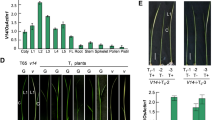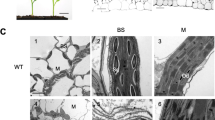Abstract
Key message
FZL is primarily localized to the chloroplast inner envelope and not to the thylakoids, but nevertheless affects the maintenance of thylakoid membranes and photosynthetic protein complexes.
Abstract
The fuzzy-onion-like protein (FZL) is a membrane-bound dynamin-like GTPase located in the chloroplast. We have investigated the chloroplast sub-localization of the endogenous FZL protein and found it to be primarily localized to the inner envelope. Moreover, we observed that mature leaves of fzl mutants start to turn pale, especially in the midvein area of the leaves, 11 days after germination. We therefore assessed their photosynthetic performance as well as the accumulation of thylakoid membrane proteins and complexes after the initial appearance of the phenotype. Interestingly, we could observe a significant decrease in amounts of the cytochrome b6f complex in 20-day-old mutants, which was also reflected in an impaired electron transport rate as well as a more oxidized P700 redox state. Analysis of differences in transcriptome datasets obtained before and after onset of the phenotype, revealed large-scale changes in gene expression after the phenotype became visible. In summary, we propose that FZL, despite its localization in the inner chloroplast envelope has an important role in thylakoid maintenance in mature and aging leaves.







Similar content being viewed by others
References
Arnon DJ (1949) Copper enzymes in isolated chloroplasts. Polyphenoloxidase in Beta vulgaris. Plant Physiol 24:1–15
Benjamini Y, Hochberg Y (1995) Controlling the false discovery rate: a practical and powerful approach to multiple testing. J R Stat Soc 57:289–300
Benz JP et al (2009) Arabidopsis Tic62 and ferredoxin-NADP(H) oxidoreductase form light-regulated complexes that are integrated into the chloroplast redox poise. Plant Cell 21:3965–3983. https://doi.org/10.1105/tpc.109.069815
Charuvi D, Kiss V, Nevo R, Shimoni E, Adam Z, Reich Z (2012) Gain and loss of photosynthetic membranes during plastid differentiation in the shoot apex of Arabidopsis. Plant Cell 24:1143–1157. https://doi.org/10.1105/tpc.111.094458
Gao H, Sage TL, Osteryoung KW (2006) FZL, an FZO-like protein in plants, is a determinant of thylakoid and chloroplast morphology. Proc Natl Acad Sci USA 103:6759–6764. https://doi.org/10.1073/pnas.0507287103
Gugel IL, Soll J (2017) Chloroplast differentiation in the growing leaves of Arabidopsis thaliana. Protoplasma 254:1857–1866. https://doi.org/10.1007/s00709-016-1057-9
Hojka M, Thiele W, Toth SZ, Lein W, Bock R, Schottler MA (2014) Inducible repression of nuclear-encoded subunits of the cytochrome b6f complex in tobacco reveals an extraordinarily long lifetime of the complex. Plant Physiol 165:1632–1646. https://doi.org/10.1104/pp.114.243741
Irizarry RA, Hobbs B, Collin F, Beazer-Barclay YD, Antonellis KJ, Scherf U, Speed TP (2003) Exploration, normalization, and summaries of high density oligonucleotide array probe level data. Biostatistics 4:249–264. https://doi.org/10.1093/biostatistics/4.2.249
Jilly R, Khan NZ, Aronsson H, Schneider D (2018) Dynamin-like proteins are potentially involved in membrane dynamics within chloroplasts and cyanobacteria. Front Plant Sci 9:206. https://doi.org/10.3389/fpls.2018.00206
Karim S, Aronsson H (2014) The puzzle of chloroplast vesicle transport—involvement of GTPases. Front Plant Sci 5:472. https://doi.org/10.3389/fpls.2014.00472
Landoni M et al (2013) A mutation in the FZL gene of Arabidopsis causing alteration in chloroplast morphology results in a lesion mimic phenotype. J Exp Bot 64:4313–4328. https://doi.org/10.1093/jxb/ert237
Lichtenthaler H, Wellburn A (1983) Determinations of total carotenoids and chlorophylls a and b of leaf extracts in different solvents. Biochem Soc Trans 11:591–592
Lohse M et al (2010) Robin: an intuitive wizard application for R-based expression microarray quality assessment and analysis. Plant Physiol 153:642–651. https://doi.org/10.1104/pp.109.152553
Low HH, Lowe J (2006) A bacterial dynamin-like protein. Nature 444:766–769. https://doi.org/10.1038/nature05312
Low HH, Sachse C, Amos LA, Lowe J (2009) Structure of a bacterial dynamin-like protein lipid tube provides a mechanism for assembly and membrane curving. Cell 139:1342–1352. https://doi.org/10.1016/j.cell.2009.11.003
Lubeck J, Soll J, Akita M, Nielsen E, Keegstra K (1996) Topology of IEP110, a component of the chloroplastic protein import machinery present in the inner envelope membrane. EMBO J 15:4230–4238
Mozdy AD, Shaw JM (2003) A fuzzy mitochondrial fusion apparatus comes into focus. Nat Rev Mol Cell Biol 4:468–478. https://doi.org/10.1038/nrm1125
Philippar K, Geis T, Ilkavets I, Oster U, Schwenkert S, Meurer J, Soll J (2007) Chloroplast biogenesis: the use of mutants to study the etioplast-chloroplast transition. Proc Natl Acad Sci USA 104:678–683. https://doi.org/10.1073/pnas.0610062104
Porra RJ, Thompson WA, Kriedemann PE (1989) Determination of accurate extinction coefficients and simultaneous equations for assaying chlorophylls a and b extracted with four different solvents: verification of the concentration of chlorophyll standards by atomic absorption spectroscopy. Biochim. Biophys. Acta 975:384–394
Schottler MA, Flugel C, Thiele W, Bock R (2007) Knock-out of the plastid-encoded PetL subunit results in reduced stability and accelerated leaf age-dependent loss of the cytochrome b6f complex. J Biol Chem 282:976–985. https://doi.org/10.1074/jbc.M606436200
Schottler MA, Toth SZ, Boulouis A, Kahlau S (2015) Photosynthetic complex stoichiometry dynamics in higher plants: biogenesis, function, and turnover of ATP synthase and the cytochrome b6f complex. J Exp Bot 66:2373–2400. https://doi.org/10.1093/jxb/eru495
Schreiber U (1986) Detection of rapid induction kinetics with a new type of high-frequency modulated chlorophyll fluorometer. Photosynth Res 9:261–272. https://doi.org/10.1007/BF00029749
Schweiger R, Schwenkert S (2014) Protein-protein interactions visualized by bimolecular fluorescence complementation in tobacco protoplasts and leaves. J Vis Exp. https://doi.org/10.3791/51327
Schweiger R, Muller NC, Schmitt MJ, Soll J, Schwenkert S (2012) AtTPR7 is a chaperone docking protein of the Sec translocon in Arabidopsis. J Cell Sci. https://doi.org/10.1242/jcs.111054
Schwenkert S et al (2006) PsbI affects the stability, function, and phosphorylation patterns of photosystem II assemblies in tobacco. J Biol Chem 281:34227–34238. https://doi.org/10.1074/jbc.M604888200
Schwenkert S, Legen J, Takami T, Shikanai T, Herrmann RG, Meurer J (2007) Role of the low-molecular-weight subunits PetL, PetG, and PetN in assembly, stability, and dimerization of the cytochrome b6f complex in tobacco. Plant Physiol 144:1924–1935. https://doi.org/10.1104/pp.107.100131
Smyth GK (2004) Linear models and empirical bayes methods for assessing differential expression in microarray experiments. Stat Appl Genet Mol Biol. https://doi.org/10.2202/1544-6115.1027
Tremblay A et al (2016) A role of the fuzzy onions like gene in regulating cell death and defense in Arabidopsis. Sci Rep 6:37797. https://doi.org/10.1038/srep37797
Urbischek M et al (2015) The extreme Albino3 (Alb3) C terminus is required for Alb3 stability and function in Arabidopsis thaliana. Planta 242:733–746. https://doi.org/10.1007/s00425-015-2352-y
Usadel B, Poree F, Nagel A, Lohse M, Czedik-Eysenberg A, Stitt M (2009) A guide to using MapMan to visualize and compare Omics data in plants: a case study in the crop species, Maize. Plant Cell Environ 32:1211–1229
van der Bliek AM, Shen Q, Kawajiri S (2013) Mechanisms of mitochondrial fission and fusion. Cold Spring Harb Perspect Biol. https://doi.org/10.1101/cshperspect.a011072
Waters MT, Langdale JA (2009) The making of a chloroplast. EMBO J 28:2861–2873. https://doi.org/10.1038/emboj.2009.264
Westphal S, Soll J, Vothknecht UC (2001) A vesicle transport system inside chloroplasts. FEBS Lett 506:257–261
Yamori W, Takahashi S, Makino A, Price GD, Badger MR, von Caemmerer S (2011) The roles of ATP synthase and the cytochrome b6/f complexes in limiting chloroplast electron transport and determining photosynthetic capacity. Plant Physiol 155:956–962. https://doi.org/10.1104/pp.110.168435
Acknowledgements
This project was funded by the Deutsche Forschungsgemeinschaft (DFG), TR175, Project B05 to J.S. and SFB1035, Project A04 to S.S. F.S. was financially supported by Rhenac Green Tec AG (Hennef, Germany) for some time of the conducted study. We would like to thank Sabine Grahl for data analysis and help with supervision. Antje von Schaewen and Jörg Meurer are kindly acknowledged for providing antisera. We would further like to thank Chris Carrie and his group for providing isolated mitochondria.
Author information
Authors and Affiliations
Corresponding author
Electronic supplementary material
Below is the link to the electronic supplementary material.
11103_2018_748_MOESM1_ESM.pdf
Online Resource 1—Phenotype of fzl-2 and fzl-3 mutant plants grown under LED light. a) Immunoblot analysis of fzl-2 and fzl-3 mutant lines using anti-FZL antiserum. Upper panel: The 10% SDS gel was loaded with 15 μg of total protein. Lower panel: Control for equal loading, showing that the antiserum cross-reacts with Rubisco. (c) Phenotypes of fzl-2 and fzl-3 mutants grown in long-day conditions under LED light (200 µM m-2 s-1) show a more pronounced pale green phenotype especially at the mid-rib region. (d) Isolated pea chloroplasts were fractionated into inner envelopes, thylakoid membranes and stroma and samples (equivalent to 15 μg protein) were loaded on a 12 % SDS gel. After electrophoresis and membrane transfer, blots were probed with the anti-FZL antiserum. Antibodies against the inner-envelope protein Tic110 and Tic40, the soluble stromal protein FBPase and the thylakoid membrane protein D1 were used as controls (PDF 300 KB)
11103_2018_748_MOESM2_ESM.pdf
Online Resource 2—Chlorophyll concentration in µg/g fresh weight. Chlorophyll concentration was measured using leaves from 10, 13 and 20-day-old plants grown in LED light, P-value > 0.00001, n > 4. Values correspond to Figure 1 (PDF 590 KB)
11103_2018_748_MOESM3_ESM.pdf
Online Resource 3—Characterization of fzl mutant plants grown under standard light conditions. (a) Phenotype of fzl mutants grown in long-day conditions under 100 µM/s/m2 light. On day 20, fzl plants show a pale green phenotype. (b) Chloroplast size measurement in fzl plants. The diameters of 50 individual chloroplasts were measured using ImageJ software based on confocal micrographs of the chlorophyll autofluorescence of 21-day old leaves. Student’s t-test was performed and P-values were calculated for the 95% confidence interval. P-value <0.00001. (c) Chlorophyll concentration was measured using leaves from 25-day-old plants grown in normal light. In the fzl plants, chlorophyll concentrations were reduced to 70% of WT levels. P-value: 0.004, n=3 (PDF 144 KB)
11103_2018_748_MOESM5_ESM.pdf
Online Resource 5—In silico modeling of FZL with BDLP. In silico structural prediction analysis was performed using Phyre2 web portal. (a) FZL (288-912 aa) structure predicted with 100% confidence interval based on the structure of GDP bound BDLP (PDB Id: 2J68). (b) One on one threading of FZL (288-912 aa) to the GDP bound BDLP protein structure (PDB Id: 2J68). (c) Structure of GDP bound BDLP (PDB Id: 2J68) (PDF 333 KB)
Rights and permissions
About this article
Cite this article
Patil, M., Seifert, S., Seiler, F. et al. FZL is primarily localized to the inner chloroplast membrane however influences thylakoid maintenance. Plant Mol Biol 97, 421–433 (2018). https://doi.org/10.1007/s11103-018-0748-3
Received:
Accepted:
Published:
Issue Date:
DOI: https://doi.org/10.1007/s11103-018-0748-3




